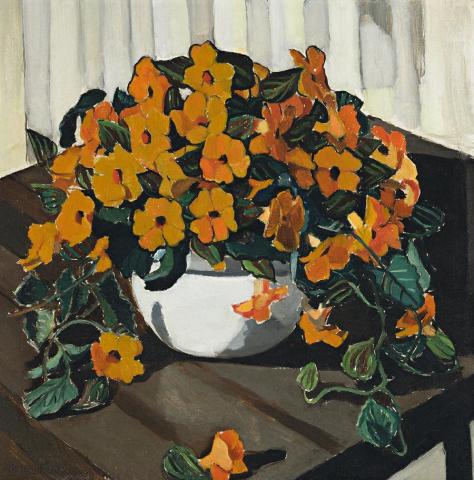THUNBERGIA (BLACK-EYED SUSAN), 1929
MARGARET PRESTON
oil on canvas
46.0 x 46.0 cm
signed and dated lower left: Margaret Preston 1929
Grosvenor Galleries, Sydney, 1929
Mrs Cuttle, Sydney, 1929 – 1989
Leonard Joel, Melbourne, 26 July 1989, lot 82
Sotheby's, Melbourne, 19 August 1991, lot 310
Sotheby's, Melbourne, 19 April 2004, lot 20
Private collection, Sydney
Sotheby's, Melbourne, 27–28 August 2007, lot 7
Private collection, Sydney
Margaret Preston, Grosvenor Galleries, Sydney, 7 – 31 August 1929, cat. 14
Australian Flower Painting 1890 – 1990, Trevor Bussell Fine Art Gallery, Sydney, May 1990
Margaret Preston Catalogue raissoné of Paintings, Monotypes and Ceramics, CD-ROM, Art Gallery of New South Wales, Sydney, 2005
The late twenties were vintage years for Margaret Preston. They saw the production of some of her best art, and witnessed her remarkable rise to fame. She created such masterly paintings as Implement in Blue 1927 (Art Gallery of New South Wales), Aboriginal Flowers 1928 (Art Gallery of South Australia), Western Australian Gum Blossom 1928 (Art Gallery of New South Wales), and Lobster 1929 (whereabouts unknown). This was paralleled by a rising public profile through wide participation in exhibitions in Australia, and in London, supported by the featured illustration of her art and articles in Art in Australia and The Home. In December 1927 a special Margaret Preston number was published by Art in Australia; and in August 1929 she held a reputedly sell-out exhibition at the Grosvenor Galleries, Sydney. Thunbergia was catalogue number fourteen, exhibited alongside Rifle Birds c1928, and one of her finest colour woodcuts, Wheel Flower c1928. Later in the same year Ure Smith and Leon Gellert published the deluxe portfolio, Margaret Preston Recent Paintings, featuring works from the exhibition. To crown this period of exceptional achievement, the Trustees of the Art Gallery of New South Wales invited Preston to paint her self-portrait for their collection of distinguished Australian artists. The eleventh in the series, Preston was the first woman to be honoured.
Thunbergia (Black-Eyed Susan) 1929, with its higher viewpoint, table top and corner setting, is compositionally related to one of Preston's most popular paintings, Australian Gum Blossom 1928 in the collection of the Art Gallery of New South Wales which was 'claimed by British novelist Somerset Maugham as the best of her pictures...'1 In Thunbergia, the highlight on the white bowl acts as a spotlight focal point, with the Black-Eyed Susans radiating in a semi-circle. Diagonal lines of the table below and vertical lines of the curtains behind provide further devices to concentrate attention on the floral centrepiece. The great attraction in both these paintings is, of course, colour - especially reds, yellows, and oranges, which glow in warm contrast to the cool, almost velvety dark greens of the leaves. In our painting Preston has placed, with great skill, the flowers in an almost neutral colour setting, allowing the warmth of the petals to add to the flowers bold attraction. Well known for prints and paintings of Australian flora, Preston liked to embrace the exotic, as in our painting. Named after the eighteenth century Swedish botanist and physician Carl Peter Thunberg, there are over one hundred varieties of this tropically inclined species. In addition to Australia, they flourish in Africa and Asia.
1. Edwards, D., et al, Margaret Preston, Art Gallery of New South Wales, Sydney, 2005, p. 276
DAVID THOMAS
